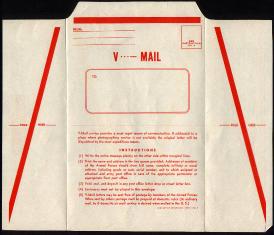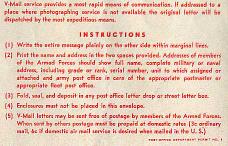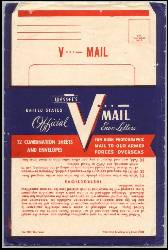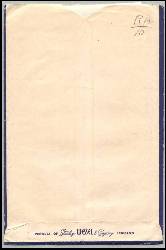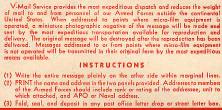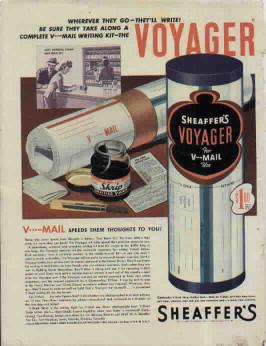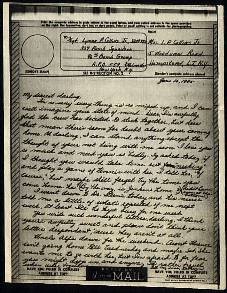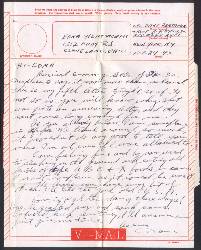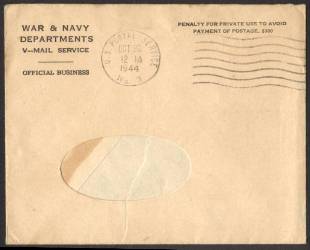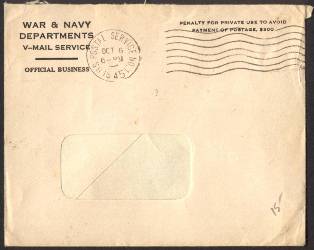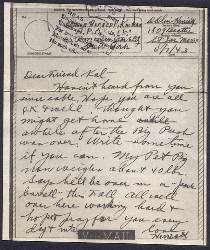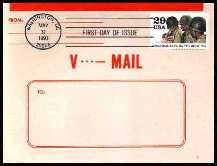

V is for V-Mail |

|

|

|

|
What is V-mail?
In the 21st century, the term has taken on
new meanings related to the www,
but during WW II, Great Britain and the US both adopted a procedure - called the
Airgraph
by the British, and V-mail by the Americans - wherein
letters to and from servicemen abroad were microfilmed on the sending end, transported
on film
by air to the destination, then re-enlarged and printed on the receiving end.
One roll of film weighing about 7 ounces could hold over 1,500 letters, saving precious
space and weight on air flights transporting supplies and mail to and from the troops.
Putting that another way, two pounds of microfilm replaced 114 pounds of letters! Over a
billion letters were sent via V-mail between 1942 and 1945.
A similar concept had been in use by the French as early as 1871, to transport
mail by carrier pigeon into and out of the besieged city of Paris (though the images
were projected onto a screen and transcribed by hand on the receiving end).
According to
THIS PAGE on the National Postal Museum website, the
space savings ratio of V-mail was 37 to 1, while that for the weight was 57 to 1 -
significant by either standard. On the other hand, only about 14 percent of mail to Navy
personnel in 1944 was V-mail, so while the system yielded significant savings, they could
have been much larger if people had used it more.
All of the above may seem pointless today, with cell phones and e-mail and virtually
instantaneous communication to almost any point on the globe, but in the 1940's even air
travel was still uncommon. No computers. No television. No space shuttle. No
satellites. No velcro. How did people survive?
To view photos of an exceptional exhibit on V-Mail from World Stamp Expo 2000 in Anaheim,
CLICK HERE - the images are crude, but if you display them
full size (or save them to your hard disk and display them enlarged), you should be able
to read most of the text. I think you will find it worth the effort.
Click on any image below to view a high-res version
HOW IT WORKED - FROM the US - STEP 1 - Writing and Mailing
First, the sender of a V-mail letter had to use one of the special forms shown below. Produced initially by the government, and later by private companies to government specifications, these were available to the public at stores in tablets and pads and packets. Opened out as shown here, they measured 8-1/2 by 11 inches (plus the tab sticking out on the side). They were supplied free to service personnel. Full instructions on their use are printed on each form. Note the way "V-mail" is printed, with dot-dot-dot-dash between the "V" and "Mail" - that's Morse code for the letter "V," and of course "V is for Victory."
The message, plus FROM and TO addresses, had to be written in the designated places on side one (the image on the left above). The FROM and TO addresses had to be repeated on side two. Then the form was folded so that side two faced out, sealed with the gummed flap, and mailed as usual. Service personnel could send them free of charge, while the general public had to add normal postage for a letter: 3¢ for surface mail, and 6¢ for air mail. Paying extra for air mail affected only the letter's journey within the US. After that it was handled within the military mail system, as described below.
Note that mail TO all military personnel was (and still is) sent to an APO (Army Post Office) or FPO (Fleet Post Office) address, at one of several military mail processing centers within the US. The main such centers during WW II were in New York City and San Francisco, so 99% of the service personnel addresses you see on V-Mail will be in one of those two cities. MORE ABOUT the APO system.
In the armed services of the US, servicemen were supplied the V-mail forms free of charge, and could send them (exclusive of extra services) free as well. Back home in the States, forms were free at first, but later had to be purchased. The images above show the outside of a privately printed packet of 12 blank forms (price = 10c), and on the right are its instructions for writing and sending a letter.
I found this ad on ebay - it shows one imaginative marketing concept to sell both V-mail and a related product. This was intended for a serviceman, with everything he needed protected in a cardboard canister. I wonder if it was ever actually used that way - I can't imagine a foot soldier lugging all this around for long.
HOW IT WORKED - FROM the US - STEP 2 - Conversion to microfilm
Once deposited in a mail box in the US, a piece of V-mail was handled initially like any other mail, i.e. it was sent via the US postal service to the address on the envelope, which for V-Mail, as well as most other mail to military personnel, was one of the two APO/FPO processing centers in New York City (serving Europe and part of Asia) and San Francisco (serving the Pacific). V-Mail service began out of NY on June 15, 1942, and San Francisco on July 10, 1942.
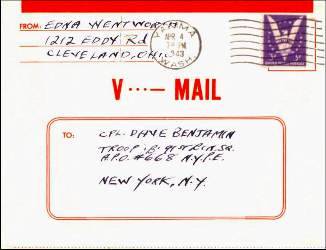
Here's what a V-letter would have looked like when it arrived at the processing station.
It measures about 4-1/2 by 5-1/2 inches.
(I had to fake this image, since the originals of V-Mail were destroyed. Let's assume Ms. Wentworth
was visiting relatives in Yakima, but lived in Cleveland.)
At the V-Mail processing center, the letter was opened, censored, sorted by destination (records were kept of the most recent locations of all military units in the field) then sent through the microfilming equipment and copied onto a roll of 16mm film along with about 1,500 other letters headed for the same location. The paper original was then destroyed, but a copy of the microfilm was saved, in case the flown reel did not make it to its destination. (Later, when the photocopy had been delivered to the recipient, the microfilm was destroyed too.) The reel of microfilm was then loaded into a mail sack and put on board the next military flight to the designated area.
HOW IT WORKED - FROM the US - STEP 3 - Conversion back to letter form and delivery
In the field, APO/FPO mail centers moved with the troops. Most had V-Mail processing capability. When such a facility received a roll of V-mail microfilm, it processed it back into letter form. Each letter was printed onto photo paper at about 1/4 its original size - about 4¼ by 5½ inches. The result was then folded, text facing out, and inserted into a special V-Mail envelope, with a window to display the address of the recipient. WIth only a few exceptions, no postal markings were applied to these envelopes in the field.
And here is what the soldier actually received - not very exciting, is it? No stamp, no postmark or cancellation. The richness of this topic is more in the appeal of learning a little about what life was like during WWII.
(Actually, I had to fake the image on the left above - actual examples of V-Mail as received by military personnel in the field are quite rare. First, keeping personal material like this was discouraged, and second, it just wasn't pratical.)
V-Mail service ended offcially on November 1, 1945, but continued for a while longer to process microfilm still "in the pipeline."
HOW IT WORKED - V-mail from the field to the US
In the other direction, the process was simply reversed. A soldier wrote a letter on the form, folded and sealed it (no stamp needed), and submitted it to be sent home. At the nearest (often mobile) field V-Mail processing facility, it was censored, microfilmed, and flown to the APO/FPO processing center in NYC, SF, or Chicago. (The center for incoming V-Mail opened in Chicago on Nov. 22, 1943.) In general, a piece of incoming V-Mail was routed to whichever of the three centers was closest to its destination. At the V-Mail center it was printed, folded, put into an envelope, postmarked, and transferred to the postal service for delivery. Below is an example of how that looked.
We have many examples of V-Mail sent back to the US by service personnel, since there were no security or space constraints to prevent its being saved. Indeed, quite the opposite was true, and V-Mail was saved by wives and parents as the only tangible connection they had with their soldiers in the field.
The item below bypassed the microfilming and was delivered to the US in its original form. The writer says he is in Africa, and a former owner wrote "Morocco" on the back, so I assume there was no V-Mail processing facility near enough to make it worth converting this, and it was sent as-is.
George Cosentini, postal historian and APO expert, who has the premier exhibit of V-Mail history in the US, commented on the item above as follows:
|
Indeed, APO 668 was in Casablanca from 12-01-42 thru early Nov 43, invasion of Sicily time.
A lot of V-Mail from North Africa is in the original form, it was very early in the game and
things did not work too well yet, and N. Africa was a mixed bag, depending where the mail was
you can find US mail cancelled by the British and vice versa.
Mail handling was done first by a Forward echelon. They were the first to pick the mail up and took it to a
Rear echelon that actualy processed the mail. The APO mail handling facilities were
always with the rear echelon. Forward echelon played postman, picked up and delivered but did no processing.
|
CANCELLATIONS
As I said above, V-Mail sent overseas received no postal markings. V-Mail coming into the US did get cancelled, but only minimally. All incoming V-Mail was processed through one of three centers: in NYC, in SF, or in Chicago. The standard cancellations applied to the envelopes at those centers varied only in the number designating each center's location - 1 for New York, 2 for San Francisco, and 3 for Chicago.


V-Mail cancels from NYC and SF
When the volume of mail exceeded a center's capacity, or if one of the V-Mail cancelling machines broke down, mail would be cancelled with the ordinary machines at that facility (all were associated with a local post office). This was fairly common.


V-Mail cancel varieties from SF
ENVELOPES
The format of the envelopes used for delivering V-Mail stayed basically the same during their lifetime, with some tuning of the address window and the text. The envelope on the left below is an earlier one, with an oval window. That was soon changed to the more practical rectangular style on the right.A specialist would recognize as well many varieties of papers and knives.
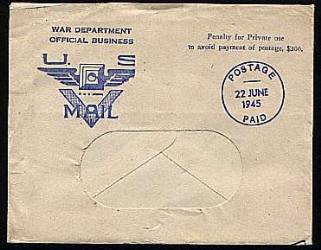
The envelope above
is one that was used for V-Mail to US military personnel stationed in the UK.
What is noteworthy about this design is that it says US MAIL, yet it was carried
in the mail service of a foreign country.
According to UK collector Stephen Dunderdale,
it was produced by the envelope manufacture John Dickinson,
who adapted machinery to produce the envelope, print the logo and postmark,
fold and insert the V-mail, all in a single operation.
EXAMPLES OF LETTERS
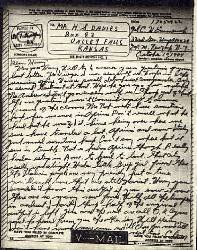
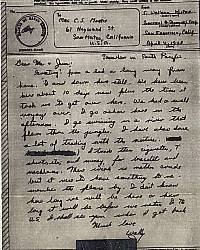
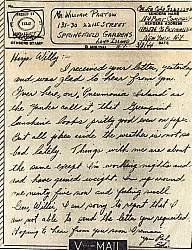
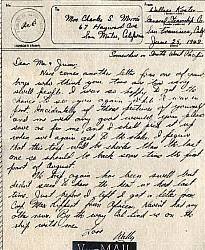
If you like reading other people's mail, V-mail is for you. Examples like the ones
above are plentiful, and can be purchased for $5 or so apiece from many stamp dealers.
I've seen some with higher pricetags, usually because they included cartoons or artwork,
or were from someone who later became famous.
Note too that the addresses of the soldiers themselves, top secret at the time, can be
translated today - all the APO and FPO numbers have been catalogued, with their locations at
specific times. See, for example, United States Numbered Military Post Offices
Assignments and locations 1941-1994, by George Cosentini and Norman Gruenzer; pub
San Diego, CA, Military Postal History Society, 1994. Here is a link
to a web page with an interesting discussion of the system of APO's, which is still in
use today.
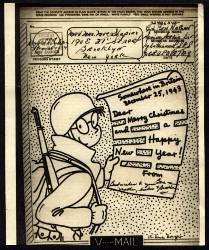
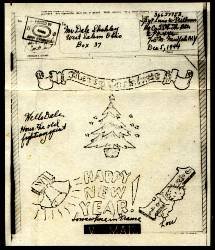

Speaking of cartoons and artwork, above are three in that category. All look to me like
forms that the sender purchased and then signed and mailed, like a Hallmark card today.
I am looking for further information about how that was handled - did the individuals who
did the art work copy and market their own products, or was there some formal system for
it?
In a way these are more poignant to me than some of the personal messages. There is more of a sense of haste and secrecy - look at the first two, one written six months before D-day (June 6, 1944), and with the note "Somewhere in Britain", the other written six months after D-Day, with the note "Somewhere in France". The last one is dated seven weeks after the surrender of Japan, when both the sender and the recipient knew it was only a matter of time before they would be reunited.
RETURNED TO WRITER
The item above is unusual for two reasons - first, it is a piece of V-Mail that was sent to a soldier in the field, complete with its envelope. We have it intact because it could not be delivered. The standard "Returned to Writer" handstamp tells us that, but none of the explanations is checked, as far as I can tell. Second, its envelope is a very early model, when someone thought it would be practical to have soldiers return the V-Mail envelopes for re-use (that's what the text "RETURN ENVELOPE TO A.P.O. FOR RE-ISSUE" is about). It is addressed to Major Alfred F. Kalberer, APO 616, and the letter inside is dated June 7, 1943, from a friend in St. Joseph, MO.
V-Mail expert George Cosentini commented on the item above as follows:
|
Address is to APO 616, with date of June 7, 1943, so Major Kalberer's unit was in Cairo, Egypt.
The envelope is a very elusive one, compared to the millions like the others you show, and its "RE-ISSUE"
note is frankly stupid as I have never seen one that could be reused; eventually they went to
a type where the window is at the far right where you could see the name of the writer which
was then used ro return it. There is also a third type, just a little bit bigger, where you can slip the
original in, envelope and all. Of all things they were called coffin envelopes...........
Envelopes carrying v-mail TO THE FIELD had no postmarks for security reasons, and needed none on return. The
handstamp is a civilian one. The V-Mail probably went first to
the Casablanca area where they tried to match the airman's name with APO 616; the note says 376th Bomb group,
probably added there. But the recipient could not be found, so it was
returned to the US, via NY, thence to 1809 Beattie, St. Joseph, MO (origin).
There was a section in NY that tried to keep up with personnel moves - are you ready for this? - using file
cards;
just for ONE division they needed 12,000 of them. As any one soldier left the US "for duty across the seas", a card was
created. Moves, transfers, deaths, it was all supposed to be reported to NY. Did they ???? Your guess is as good as
mine,
so when the military figured out that this letter could not be delivered, back to NY, handstamp added, and somebody
penciled the address on it.
It is also possible that the name was checked in the US and the note never left here, with the name being on deceased
list, POW list, MIA list. Some things you have to weigh the situation and go with your best gut
feeling. We can only make up the scenario, but what really happened, who knows.
You will also see envelopes that have the piece of paper just to the right of the window, slit, ripped, whatever, all
the way to the right, where the writer's name is now visible. Normally that is not a good sign.
They also had to change the way they handled mail, especially V-Mail, because if they made sure that there was a dead
body they were dealing with, if they sent it back right away, it was possible for the family to get the envelope with
some kind of marking stating that he was no longer around, even before the dreaded walk up the driveway of some officer
that delivered the bad news in person.
The fellow in question was in a bomber group and in those days to be in the air force was very, very dangerous, so it
is very possible that by the time the vmail was to be delivered, he was no longer with us. Or maybe a POW. Flying out of
Egypt, they might have been dropping bombs on Rommel and his band of merry men, and while eventually they got beat up,
they could still hurt you.
|
I decided to Google "376th Bomber Group WWII" and found several extensive sites about the group, including mention of Alfred Kalberer as a pilot. On a whim, I decided to go a step further, and Google Kalberer himself, and was astonished to find THIS PAGE. SO there's a happy ending to this story. The letter was returned because by the time it reached his unit, Major Kalberer was on the way back to the States for B-29 training, and his subsequent career was long and distinguished, to say the least. (And the only remaining question I have about this item is How did it make its way into the stock of the postal history dealer from whom I bought it?)
AIRGRAPHS

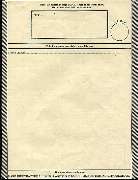
The British were actually first with the idea, and called it the Airgraph.
Above is a later version of their form.
The first Airgraph flight was on April 17, 1941, from Cairo to London.
Over 330 Million Airgraphs were sent during WW II.
For a lot more about the Airgraph service, see my new A is for Airgraph page
Everything You Could Want to Know About V-Mail
At World Stamp Expo 2000 in Anaheim (yes, I was one of the two people who attended), there was an astonishing exhibit of V-Mail and related material. I took some photos with my digital camera, and have put them on a web page of their own.The exhibit's author is George Cosentini, who gave me his kind permission to reproduce these scans here. He tells me the exhibit is "dormant" at present, but if you ever get a chance, I highly recommend you make every effort to see it - until then here are the photos - they are crude, but show enough to whet your appetite for more, I hope.
Here's a modern V-mail souvenir cover George created with the V-mail stamp from the 1995 WW-II commemorative pane.
Feedback
4/2/2003 - a reader wrote to share the following personal reaction to the page above:Thank you very much for your interesting articles on V-Mail. When my mother died recently I found a number of them that my parents had used during WWII. Many of them were addressed from my father to me. I was 6 months old when my father who was 30 was drafted into the Navy. Over the next two years my mother and father wrote a regular letter or air mail letter to each other EVERY day. My mother also wrote a letter from me and my father mailed a letter to me every day. My mother kept all these letters, all the cards, even the telegrams about leaves and the train tickets. Since my father hated being in the Navy on a ship (he was in the army national guard when he was drafted) reading these letters has given me a better idea of just how great were the sacrifices they made.
LINKS
Here's a link to a site with an interesting page about V-mail and scouting.
Here's a page about
V-mail and
advertising.
And here's an
enlargement of the magazine ad on that page.
(Courtesy of
Ad*Access at the Duke
University Library web site.)
Here's a poster promoting the use of V-mail. (Courtesy of Northwestern University Library)
| Home | U is for UPU <<< | Contents | >>> W is for War | Credits |
All text Copyright © 2000, William M. Senkus
Send feedback to the webmaster: CLICK HERE
Revised -- 5/09/2007


